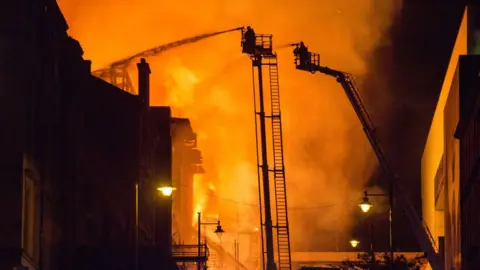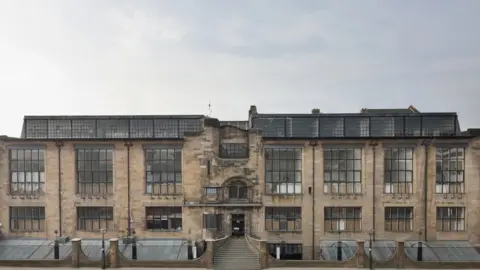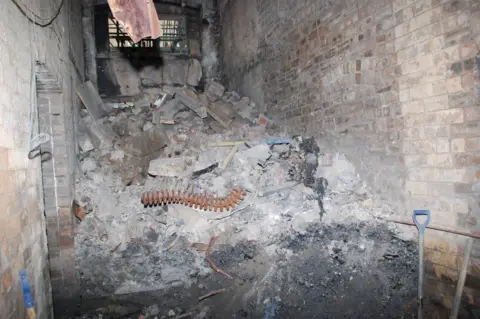Glasgow School of Art fire: Few answers and many, many questions
 Getty Images
Getty ImagesOne hundred and seventy two weeks of sifting through hundreds of tonnes of debris, CCTV and witness statements. Even Covid didn't halt for long the investigation - the largest and most complex ever undertaken by the Scottish Fire and Rescue Service.
And yet, three and a half years after the devastating fire which destroyed the Mackintosh school, there are few answers and many, many questions.
Here's what we do know about the day of June 15th 2018.
It was a Friday at the end of term, graduation day, and events were being held across campus, but not in the Mackintosh building where subcontractors were sanding floors, and repairing lead work on the flashings on the roof.
A BBC documentary crew was filming in the almost completed library, which had been destroyed in the previous fire, four years before.
They were among 101 people who were signed in and out of the visitor's book that day. The last of them left at 5pm.
Security staff took over, day shift handing over to night shift at 6.20pm.
Scaffold and fire alarms were set once the contractors left, although other statements referred to ongoing faults with the systems. They, like so many other pieces of evidence, were destroyed in the fire.
 Getty Images
Getty ImagesThe first possible indication of fire in the vicinity was more than 90 minutes before the first 999 call. A member of the public noted a "smell of burned material" as they walked along Renfrew Street, but attributed it to the ongoing renovation or a residual fire smell.
At 11.10pm, the night security guard heard a series of noises from the external scaffolding. He checked, returned to his desk and heard a further noise. This time, he checked inside the building and that's when he found fire and sparks in a crawl space or duct on the fourth floor. He called 999 at 11.19pm and left the building.
The Scottish Fire and Rescue Service examined a number of possible scenarios from wilful fire raising to electrical faults.
They said it was impossible to rule out the possibility of fire raising (although the report concluded that neither of the security guards, as the only authorised people in the building, had any involvement in the fire).
 McAteer Photograph
McAteer PhotographTheir conclusion due to the extensive damage and the lack of physical evidence is that the cause of the fire is "undermined".
But they can be clear about the factors that allowed this fire to take a grip so quickly.
The duct system - designed by Mackintosh for ventilation - which proved so devastating in the fire of 2014 also wreaked havoc in 2018, fuelling the flames with an unlimited air supply, and speeding the development of the fire. Within 38 minutes of the fire service arriving, half of the building was alight.
And that leads the SFRS to make a number of strong recommendations for future projects. As Holyrood's culture committee was told, shortly after the fire, historic buildings are most at risk during renovation work.
 SFRS
SFRSThe report concludes that future projects should appoint "competent persons with the appropriate skills, knowledge, qualifications and experience " to make sure full fire risks are considered, and a Fire Risk Assessment put in place.
It should be continuously reviewed and evaluated.
In both cases no one was injured or killed. But the emphasis of fire safety, until now, has been protection of life.
What the largest, most complex investigation in Scotland's fire history concludes, is that buildings need protection too, especially ones as unique and as irreplaceable as the Mack.
